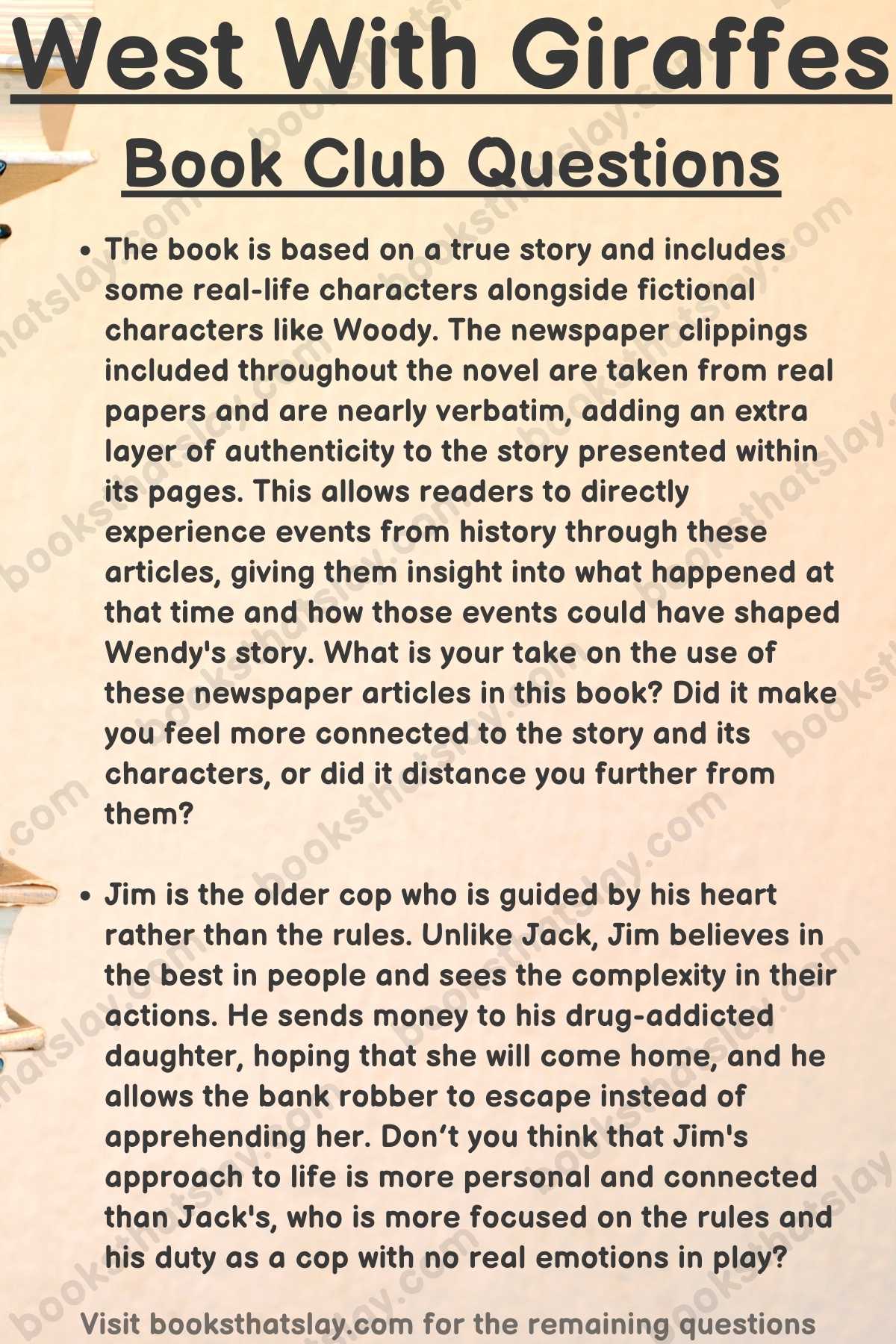13 West With Giraffes Book Club Questions
The dust-swept plains, the gentle giants, and a young man’s extraordinary journey – that’s West With Giraffes for you.
If Lynda Rutledge’s historical adventure novel, “West with Giraffes” captured your heart, you’re in for a treat! We have crafted some thought-provoking questions to spark a lively book club discussion.
Dive into themes of self-discovery, animal sentience, and the power of memory as you revisit this unforgettable journey.

West With Giraffes Book Club Questions
- This novel explores the treatment of animals and includes scenes where people cheer for the giraffes on their journey and gawk at them in the zoo. In 1938, zoos were considered a source of entertainment and education but lacked modern regulations and perspectives surrounding animal welfare. How does this novel, set in 1938, challenge or reinforce your understanding of the ethics surrounding zoos and the way we view captive animals?
- Woodrow carries heavy emotional trauma due to his father’s death and how his family fell apart. This trauma manifests as fear and guilt throughout his journey. Despite this, he demonstrates great resilience, overcoming the challenges of the road and choosing empathy over his own needs. How does Woodrow’s trauma shape his actions, and in what moments does his resilience shine the brightest?
- The novel has a distinct framing device – Woodrow is an old man narrating his younger life. Storytelling and memory are central themes, explored through Red’s photo-essay project and ultimately Woodrow’s written records. Why do you think the author chose this structure, and how does the concept of storytelling connect to the novel’s other central themes of resilience and growth?
- The 1938 backdrop of the Great Depression plays a role in decision-making. At one point, Woodrow seriously considers Percival’s offer of riches for the giraffes, despite knowing Percival’s ill intentions. How does the harsh economic reality of the Depression influence Woodrow’s moral dilemmas, and how does he ultimately balance his own needs with his evolving understanding of right and wrong?
- The giraffes themselves take on a symbolic role in the story, representing hope amidst hardship. People flock to see them on their journey, finding in them something beyond the troubles of the era. How does the giraffe’s physical appearance, vulnerability, and journey mirror the larger themes of the novel, and in what way do they represent hope for both Woodrow and the crowds who follow them?
- While the novel focuses on Woodrow’s adventure, it subtly weaves in other pressing social issues of 1938 – racism, sexism, and economic disparities. How do Woodrow’s experiences with figures like the Jacksons or with Red challenge his initial prejudices and preconceptions, widening his worldview?
- Woodrow and Red’s connection is fleeting but intense. Red’s choices, both selfless and harmful, reveal the complexities of love and sacrifice. How does the novel explore different facets of love – romantic, platonic, familial – and how do acts of sacrifice shape the characters?
- Woodrow’s loyalty is constantly tested. He feels devotion to the giraffes, but also loyalty to those who help him (Riley, Red) and those he fears (the law back home). In balancing these loyalties, he sometimes makes choices with unintended consequences. How do his loyalties clash, and does he eventually find a true sense of belonging that aligns with his moral compass?
- The theme of loss runs deeply throughout the story: loss of family, loss of love, and eventually the inevitable loss of time. Yet, in his old age, Woodrow finds purpose in storytelling and preserving memory. How does he transform the pain of loss into a sense of purpose, and why is his determination to pass on the story so important to him?
- Through Woodrow’s journey, the novel suggests that stepping outside of one’s comfort zone brings about profound self-discovery. But what happens when those adventures bring up past traumas? How does Woodrow reconcile his desire for adventure with his inner pain, and in what ways does the adventure become both a form of escape and confrontation?
- Woodrow develops a special bond with the giraffes, crediting them with a wisdom and understanding beyond human comprehension. Does the novel suggest that there is something unique about giraffes that makes them so important to Woodrow, or is his connection a reflection of the potential for bonds between humans and all animals?
- Percival and his accomplices represent a cruel, exploitative view of animals. While the novel takes a clear stance against such cruelty, it also shows its prevalence in the 1930s. How does the book create a sense of tension between modern-day empathy for animals and the harsh realities of the time period it portrays?
- Memory can be both a burden and a blessing. Woodrow is haunted by his past, but also finds solace in memories of Red and the giraffes. In what ways does the novel explore the complex nature of memory, particularly traumatic memory, and its effect on how we shape our own stories?
Check out our discussion questions for other books